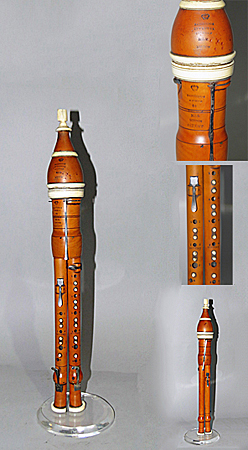
Owner: HWMC
Catalog#: 2CL-AEWF-6
Flutes - Recorders
Double Flageolet -Bainbridge & Wood
London, England, United Kingdom
William Bainbridge & John Wood
Ivory, boxwood, nickel-silver
ca. 1808-1812 CE
Height: 18.75 in; Diameter 2.25″
Wind Instruments – Woodwind Instruments – Flutes – Recorders
The upper segment is stamped: “BAINBRIDGE / & WOOD / 35 / HOLBORN / HILL / LONDON / PATENT.
This is a double flageolet made of boxwood, ivory, and nickel-silver keys, made by William Bainbridge and John Wood. The flageolet or flagelet is an end-blown fipple (duct) flute like the recorder and whistle. The lower tubes are equal in length, with 4 nickel-silver keys and 6 finger holes. The double bodies enabled a countermelody or a drone (continuous pitch) to be played at the same time as the main melody.
All keys are numbered and lettered for easy reference for the player. The holes are separated by ivory finger studs to guide the player. William Bainbridge was a respected flutist, flageoletist, oboist, instrument maker, and sheet music publicist. He was also an inventor and is accredited with developing the “Improved English Flageolet” as well as the double and triple flageolets. Bainbridge came into partnership with Wood from 1808 to 1812.
Unlike the recorder that was overlooked because of the popularity of the flute, the flageolet remained in use after the baroque period. It was played during the nineteenth century and remained popular until about 1914.
